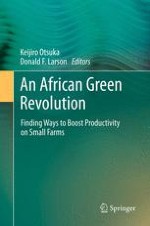2013 | OriginalPaper | Buchkapitel
6. Causes and Consequences of NERICA Adoption in Uganda
verfasst von : Yoko Kijima, Keijiro Otsuka
Erschienen in: An African Green Revolution
Verlag: Springer Netherlands
Aktivieren Sie unsere intelligente Suche, um passende Fachinhalte oder Patente zu finden.
Wählen Sie Textabschnitte aus um mit Künstlicher Intelligenz passenden Patente zu finden. powered by
Markieren Sie Textabschnitte, um KI-gestützt weitere passende Inhalte zu finden. powered by
